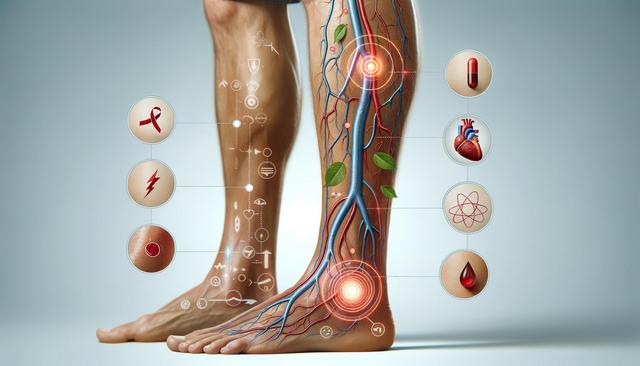Understanding Deep Vein Thrombosis (DVT)
Deep vein thrombosis, commonly referred to as DVT, occurs when a blood clot forms in a deep vein, typically in the legs. These clots can obstruct blood flow and, if left untreated, may lead to serious health complications such as pulmonary embolism. DVT is often caused by prolonged immobility, certain medical conditions, surgery, or injury to a vein. Being aware of the underlying factors that increase DVT risk is essential for both prevention and early detection.
Common causes and risk factors for DVT include:
- Prolonged bed rest or sitting for long periods (e.g., long flights or car rides)
- Recent surgery or injury, especially involving the lower limbs
- Obesity or excess body weight
- Family history of blood clots
- Use of certain medications, such as birth control pills or hormone replacement therapy
- Smoking and dehydration
Understanding these factors can help individuals take proactive steps toward preventing the formation of blood clots in the legs.
Recognizing the Early Symptoms of Blood Clots in the Leg
The early symptoms of blood clots in the leg can vary from person to person, but there are several common signs to be aware of. These symptoms may develop gradually or appear suddenly, depending on the severity and location of the clot. Recognizing them early can significantly increase the chances of effective treatment and prevent further complications.
Some of the most common early symptoms include:
- Swelling in one leg, often below the knee
- Pain or tenderness in the leg, which may feel like a cramp or soreness
- Red or discolored skin on the leg
- A feeling of warmth in the affected area
- Visible surface veins that appear swollen or more prominent than usual
If any of these symptoms are present, it is important to seek medical attention promptly. Early diagnosis can lead to better outcomes and reduce the risk of the clot traveling to the lungs or other vital organs.
Diagnostic Methods and Medical Treatments
Once a blood clot is suspected, healthcare providers use various diagnostic tools to confirm the presence of DVT. These may include physical examinations, blood tests (such as a D-dimer test), and imaging techniques like ultrasound. Accurate diagnosis is the first step toward effective blood clot removal and management.
Medical treatments for DVT typically involve:
- Anticoagulant medications (blood thinners) to prevent further clotting
- Thrombolytic therapy in severe cases to dissolve clots quickly
- Compression stockings to improve circulation and reduce swelling
- In rare cases, surgical procedures like thrombectomy may be recommended
These treatments aim to prevent the clot from growing, reduce symptoms, and lower the risk of complications. It’s important to follow the treatment plan carefully and attend any follow-up appointments to monitor progress.
Natural Prevention Strategies for Blood Clots
While medical treatment is critical once a clot has formed, there are several natural approaches that may help prevent blood clots from developing in the first place. These preventative strategies are especially important for individuals at higher risk due to lifestyle or medical history.
Some effective natural prevention methods include:
- Staying physically active—regular exercise improves blood flow and reduces clot risk
- Staying hydrated to help maintain proper blood viscosity
- Eating a balanced diet rich in anti-inflammatory foods such as leafy greens, berries, and fatty fish
- Avoiding prolonged periods of sitting—take breaks to walk or stretch, especially during travel
- Wearing compression garments if recommended by a healthcare provider
- Managing chronic conditions like diabetes, hypertension, or high cholesterol
Incorporating these habits into daily life can support overall vascular health and reduce the likelihood of clot formation naturally.
When to Seek Medical Help and Ongoing Care
Knowing when to seek medical attention is vital. If early symptoms of DVT are present, or if there’s sudden chest pain, shortness of breath, or coughing up blood, emergency care is necessary. These can be signs that a clot has traveled to the lungs, resulting in a potentially life-threatening pulmonary embolism.
Long-term care may also be required for individuals with a history of blood clots. Regular check-ups and monitoring through blood tests help ensure that the condition is managed effectively. Lifestyle adjustments, along with a tailored treatment plan, can significantly reduce the risk of recurrence.
Some tips for ongoing care include:
- Adhering to prescribed medications and reporting any side effects
- Monitoring leg health and watching for new symptoms
- Maintaining a healthy weight and quitting smoking
- Discussing any planned surgeries or travel with a healthcare provider
By staying informed and proactive, individuals can manage the condition effectively and maintain a good quality of life.
Conclusion: Staying Alert and Taking Preventive Steps
Recognizing the early symptoms of blood clots in the leg is essential for timely intervention and treatment. Deep vein thrombosis can pose serious health risks, but with proper awareness, diagnosis, and care, it is manageable. Incorporating natural prevention strategies, staying active, and working closely with healthcare professionals can significantly reduce the risk of blood clot formation. Being alert to changes in your body and taking preventive action can make a meaningful difference in your overall vascular health.






